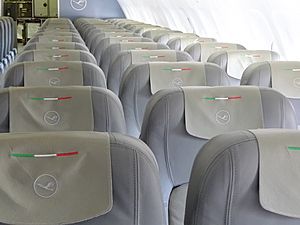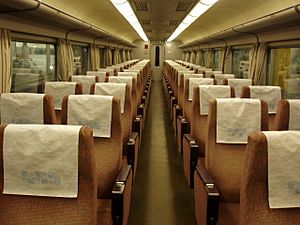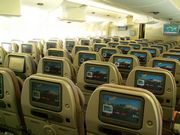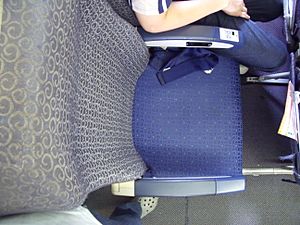Economy class facts for kids
Economy class, also known as coach class or standard class, is the most basic and usually the cheapest way to travel. You can find it on airplanes, trains, and some ferries or boats. It generally offers a seat and basic services, making travel affordable for many people.
Contents
Travel by Sea: Economy on Ships and Ferries

Long ago, in the 1700s, ships had different ways to travel. There was "cabin class" for wealthier passengers, who had small rooms and a shared dining area. Then there was "steerage," which was for poorer travelers. These passengers stayed in open areas, often near the ship's steering gear. They usually slept in bunks and cooked their own food.
When steamships became popular, companies started offering more choices. Some ships, like those used for immigration, added "Third Class." This class gave passengers small shared cabins and regular meals. Over time, large ships sometimes had four different classes: First, Second, Third, and Steerage. Each had its own dining and fun areas.
After the 1920s, fewer people traveled by ship to immigrate. So, "steerage" was stopped. "Third Class" cabins were often made nicer and called "Tourist Class." This became the main low-cost option for ocean travel, especially after World War Two.
By the 1960s, many ocean liners changed to become cruise ships. Most became "one class" to make things simpler. However, modern cruise ships still have different levels of fancy services and special dining spots. Many ferries that travel shorter distances still offer both private cabins and large open areas for economy travelers, much like the old "cabin" and "steerage" days.
Economy Class on Trains
On trains in North America, economy class is often called "coach class." In Europe, it's usually called "second class." In the United Kingdom and Ireland, it's known as "standard class."
In India, the lowest class was once called "third class" during British rule. After India became independent, it was renamed "second class." Today, Indian Railways also has an "Economy AC-3" class. In Indonesia, the cheapest train class is "economy class." Many people use it for long trips. At first, these trains didn't have air conditioning. But now, PT Kereta Api offers "Ekonomi AC" trains, which means "Air conditioner economy."
Most economy class train seats are simple. They often have a fold-down tray and can recline a bit. There might be a pocket on the seat in front for magazines. You can usually store your luggage in overhead racks or at the ends of the train cars.
Some standard class seats on British trains have permanent tables. You might find power sockets and Wi-Fi (sometimes for a fee). In Europe, second class often has open cars with seats arranged in pairs. These can be in rows or facing each other. Some express trains have small rooms with six to eight seats.
In Spain, second-class cabins on fast AVE trains are called "Tourist class." They have electric sockets and offer video and audio entertainment on most routes.
North American trains usually don't include meals with economy tickets.
Economy class also exists on some sleeper trains. For example, in Russia, it's called "Platzkart." These cars have an open layout with many bunk beds. The lower bunks can be used as seats during the day. Some European trains also have similar "coach class" sleeper cars, called Couchette cars.
Economy Class on Airplanes

Economy class seats on airplanes usually recline and have a fold-down table. The space between seats, called "seat pitch," is usually about 30 to 32 inches (76 to 81 cm) for domestic flights. For international flights, it can be 30 to 36 inches (76 to 91 cm). The width of a domestic economy seat is usually around 17 to 18.25 inches (43 to 46 cm).
In the pocket on the seat in front of you, you'll often find an airsickness bag, the airline's magazine, a duty-free catalog, and a safety card. Depending on the airline, you might also get a blanket, a small bag with things like earplugs or an eye mask, and headphones.
For In-flight entertainment, some planes have a large screen at the front of the cabin for everyone to watch. Others have individual screens for each seat, where you can choose what to watch. Some low-cost airlines might charge you for headphones.
Food availability also varies. Some major airlines no longer serve free meals on short flights. Meals are now usually only provided on international flights. Some airport shops sell packaged meals you can bring onto your flight. Low-cost airlines like EasyJet and Ryanair often charge for all food and drinks, even on short flights. Many airlines also charge economy passengers for checking in at the airport, checked bags, pillows, blankets, and headphones.
Many airlines have created a slightly better economy class, sometimes called "Economy Plus." These seats might have a bit more space between them. These improved economy classes often bring back some of the comfort and services that were common in economy class many years ago.
Images for kids
-
Third Class cabin aboard the RMS Olympic, Titanic's sister ship
-
Economy Class on an Emirates Boeing 777-300ER








